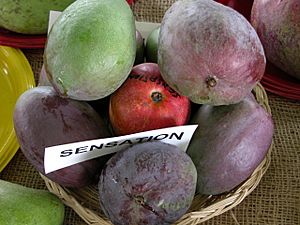Sensation (mango) facts for kids
Quick facts for kids Mangifera 'Sensation' |
|
|---|---|

'Sensation' mangoes at the Tropical Agricultural Fiesta in the Fruit and Spice Park in Homestead, Florida
|
|
| Genus | Mangifera |
| Species | Mangifera indica |
| Hybrid parentage | 'Haden' x 'Brooks' |
| Cultivar | 'Sensation' |
| Origin | Florida, US |
The Sensation' mango is a special kind of mango that ripens later in the year. It first grew in south Florida and was once grown a lot by farmers.
How the 'Sensation' Mango Started
The very first 'Sensation' mango tree grew from a seed planted in North Miami, Florida way back in 1935. For many years, no one knew which mango trees were its parents. But in 2005, scientists did a special study called a "pedigree analysis." This study showed that 'Sensation' was probably a mix of two other mango types: 'Haden' and 'Brooks'.
The tree first grew fruit in 1941. In 1949, it was given the name 'Sensation'. The tree was then moved to a plant nursery in Perrine, Florida by J.B. Carmichael. This is where people started to grow more 'Sensation' mango trees from it.
Even though 'Sensation' mangoes had a beautiful color and the trees grew a lot of fruit, they had a problem. Sometimes, the fruit didn't ripen evenly. Because of this, farmers didn't grow them as much for selling. It also didn't become a very popular mango for people to grow in their backyards in Florida. Still, you can find some 'Sensation' trees in older mango farms today.
Where You Can Find 'Sensation' Mangoes
'Sensation' mango trees are part of special plant collections. You can find them at the USDA's plant bank in Miami, Florida. They are also at the University of Florida's Tropical Research and Education Center in Homestead, Florida. Another place to see them is the Miami-Dade Fruit and Spice Park, which is also in Homestead. These places help keep different types of plants safe for the future.
What the 'Sensation' Mango Looks Like
The 'Sensation' mango fruit is shaped like an oval and usually weighs less than one pound. It might have a small bump at the top, or sometimes no bump at all. The most special thing about this mango is its skin color, which is a deep plum red. The skin often has many small, pale yellow dots on it. These mangoes often grow in groups or bunches on the tree.
Inside, the fruit has light yellow flesh. It has very fine fibers, which means it's smooth to eat. The taste is gently sweet with a light, pleasant smell. Each fruit has one seed inside. In Florida, 'Sensation' mangoes are ready to eat from late July to September. This makes them a "late-season" mango, meaning they ripen later than many other types.
The 'Sensation' mango tree grows well and strongly. It has an "open canopy," which means its branches spread out, letting light and air through.

